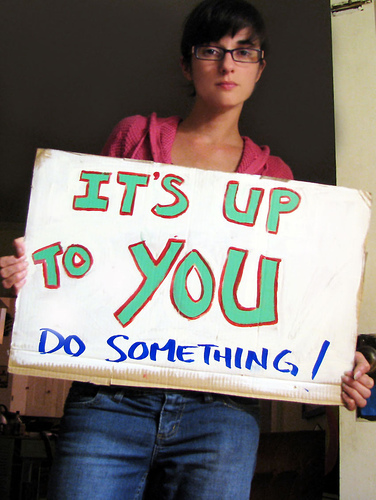|
|
|
Monday, March 4th, 2013
 Two stories today made me really happy. Two stories today made me really happy.
Happy that I won’t be around to see the world that the Silicon Valley mentality is working frantically to make happen. (I say ‘mentality’ because startups are all over as is the mindset described.)
It’s a world of instant solutions, from quasi-immortality, postmortem tweets from soon-to-be-launched LivesOn, to futurist Ayesha Khanna’s idea for smart contact lenses that would make homeless people disappear from view—out of sight/out of mind.
Solutionists err by assuming, rather than investigating, the problems they set out to tackle. Given Silicon Valley’s digital hammers, all problems start looking like nails, and all solutions like apps.
And then there is Seesaw, which allows you to “crowdsource absolutely every decision in your life” and practically guarantees siloed, homogenized attitudes over the long-term.
The drive seems to be to avoid thinking in general, let alone any of the less comfortable deep thinking required to mature and develop anything vaguely resembling wisdom.
Leszek Kolakowski argued that, given that we are regularly confronted with equally valid choices where painful ethical reflection is in order, being inconsistent is the only way to avoid becoming a doctrinaire ideologue who sticks to an algorithm. For Kolakowski, absolute consistency is identical to fanaticism.
Or as Emerson said long before the rise of today’s technology, “A foolish Consistency is the hobgoblins of little minds, adored by little statesmen, philosophers, and divines. With consistency, a great soul simply has nothing to do.”
The main problem with so many innovators is that they want to solve problems with an algorithm, which ignores the entire messy human equation; much like medicine desperately wants to believe that one-dose-fits-all.
Nor, in the rush to innovate, do they give much thought as to the longer-term effects of their miracles.
The interactive dialog provided by digital media was hailed as a way to draw millions more into the dialog, which sounds great until you look at the real effect of negative comments on stories.
Comments from some readers, our research shows, can significantly distort what other readers think was reported in the first place. (…) The results were both surprising and disturbing. Uncivil comments not only polarized readers, but they often changed a participant’s interpretation of the news story itself.
Turns out it’s not so much the comment, but the tone that has the greatest effect.
So. No discussion, no disagreement within your little world, no ethical dilemmas, no deep thinking, mental struggle, stretching or growing.
Maybe no innovation.
Is this the world in which you want to live?
Flickr image credit: Igor Schwarzmann
Posted in Innovation | No Comments »
Wednesday, October 3rd, 2012
 Monday I said “Not all challenges can be overcome (more abut that Wednesday); sometimes you can find work-arounds, others you just need to accept.” Monday I said “Not all challenges can be overcome (more abut that Wednesday); sometimes you can find work-arounds, others you just need to accept.”
Based on the emails I received it’s a good thing I said we’d look at that idea Wednesday.
Before the Boomers people had problems, but after that giant wave entered the adult world “problems” morphed into challenges and challenges were something to be solved and overcome.
But is that always necessary?
Based on my personal experience I don’t think so.
Whether I consider it a problem or a challenge, here is what I do.
- Take a few steps back to get some perspective. I want to see the whole thing; not just the bit that has blocked me.
- Consider my approach; I can
- ignore it, detour around and continue down my path;
- identify exactly what is in my way and address only that part;
- develop a solution that eradicates it completely; and
- recognize and accept that it is completely out of my hands.
-
I start with my sixth rule; beyond that determining which of the three is applicable is a very personal decision. Over the years I’ve found the breakdown roughly as follows:
70% of the time I find number one works just fine.
20% fall in the second category.
8% have the capacity to pop up over and over and need to be solved.
2% are unsolvable and just need to be endured.
Flickr image credit: Eli Christman
Posted in Personal Growth | No Comments »
Wednesday, May 2nd, 2012
“In many ways, it’s not my generation’s fault that Japan has so much debt,” he said. “But blaming others won’t get us anywhere. We just need to find a way forward. It’s the responsibility of all of us born into this age.” –31 year old Naomichi Suzuki, the youngest mayor of the country’s most rapidly aging city.
You could do much worse than incorporate Naomichi Suzuki’s attitude into your company culture, life and as an integral part of your MAP.
Organizations and individuals spend inordinate amounts of time and energy assigning blame and indulging in recriminations.
 At times it seems they want apologies more than solutions. At times it seems they want apologies more than solutions.
Look not just around you, but also in the mirror, and you’ll find at least one such active situation (say thanks if it’s only one).
Assigning fault is necessary in certain circumstances, usually when specific legal and societal laws are broken by specific, identifiable individuals.
Assigning responsibility is most productive when used as a learning experience, again for specific, identifiable individuals.
Solutions that move the situation forward are where time, energy and resources should be focused, but for some it’s more about them than solving the problem.
“Supporters of the defeated Ms. Iijima [the losing candidate] dominate the city council, blocking proposals and hurling criticism at the young mayor.”
The question all individuals must answer for themselves is what’s most important,
- my way or
- solving/moving forward.
Flickr image credit: Patrizio Cuscito
Posted in Culture, Personal Growth | No Comments »
Sunday, December 11th, 2011
 I love words; I love putting them together to express my thoughts and I love how others do the same; especially when they do it with the skill and flair of H. L. Mencken. I like Mencken because he is the best type of cynic and also has a wonderful flair for irreverence. I love words; I love putting them together to express my thoughts and I love how others do the same; especially when they do it with the skill and flair of H. L. Mencken. I like Mencken because he is the best type of cynic and also has a wonderful flair for irreverence.
Let’s start with his definition of a cynic, “A cynic is a man who, when he smells flowers, looks around for a coffin.” That’s Mencken, pithy and to the point.
He also offers a wonderful explanation of criticism, one that bosses and parents would do well to consider, “Criticism is prejudice made plausible.”
Mencken said “A society made up of individuals who were all capable of original thought would probably be unendurable.” It makes you wonder what he would think of Twitter and its ilk.
His commentary on business success is certainly proven daily, “Nobody ever went broke underestimating the taste of the American public.”
The next time you hear someone say they’ll “fix it, no problem” you would do well to remember this immutable Menckenism, “There is always an easy solution to every problem – neat, plausible, and wrong.”
Finally, in a salute to himself, Mencken declares, “All men are frauds. The only difference between them is that some admit it. I myself deny it.”
Join me next week for a tour of Mencken’s irreverent view of politics and democracy that will provide great zingers for holiday get-togethers and leave you chuckling.
Image credit: Wikipedia
Posted in Quotable Quotes | 2 Comments »
Tuesday, August 30th, 2011

This article on decision fatigue should be mandatory reading for every manager and worker looking to boost group performance or their own.
It provides scientific explanations why
- interviews are more difficult if you struggled that morning with decisions about what to wear and the best route to the company;
- the wrong candidate is hired and the real catch gets away;
- getting married often lowers productivity (not the reasons you might expect);
- skipping lunch is as bad as skipping breakfast (which is just plain stupid);
- having snacks available and buying dinner when working late is required and
- timing meetings and other critical tasks can make a significant difference.
Decision fatigue is the price every human pays for the multitude of choices we face daily; not just the obvious big ones, but every tiny fork in the road.
“No matter how rational and high-minded you try to be, you can’t make decision after decision without paying a biological price.”
Moreover, decision fatigue is a major contributor to ego depletion.
“…ego-depleted humans become more likely to get into needless fights over turf. In making decisions, they take illogical shortcuts and tend to favor short-term gains and delayed costs.”
Not exactly the actions you want in yourself or your people.
The focus on food is obvious once you think about it. Most people know you can’t exercise without providing fuel for their muscles, but seem to think their mind runs on air and desire.
“…psychologists neglected one mundane but essential part of the machine: the power supply. The brain, like the rest of the body, derived energy from glucose…”
Decision fatigue also impacts self-control, AKA willpower, and self-control has a large role in keeping us focused.
Read the article; it provides a scientific basis for creating a culture that helps people deal with decision fatigue and all its ramifications.
“When there were fewer decisions, there was less decision fatigue.”
The solutions lie in an open exploration of the subject with your people and a conscious effort to provide an environment that minimizes the effects of decision fatigue.
“The best decision makers are the ones who know when not to trust themselves.” – Lead researcher Roy F. Baumeister, social psychologist
Flickr image credit: ZedBee | Zoë Power
Posted in Culture, Ducks In A Row | 3 Comments »
Monday, January 25th, 2010
 I’m not a sports fan so I rarely read sports articles, but this one from ESPN’s Mike Reiss caught my eye. Although he was talking about the Patriots, I believe it is applicable on a much wider stage. I’m not a sports fan so I rarely read sports articles, but this one from ESPN’s Mike Reiss caught my eye. Although he was talking about the Patriots, I believe it is applicable on a much wider stage.
Have we gone leadership crazy? …
In an instant, got-to-have-it-now society, the knee-jerk conclusion that the Patriots lacked leadership seemed to be one that many rallied around. … But to lay the season’s struggles on that is overlooking the more important issues: The Patriots need more playmakers, management needs to be sharper in identifying and keeping that talent, and coaches need to be better at cultivating, scheming, and communicating with players when their situations get sticky… Start there, then factor in the importance of better locker-room chemistry, and you’ll have a more accurate reflection of what went wrong in 2009 and what steps the club needs to take in 2010 to improve.
No matter where you look, business or politics, you’ll find that most commentary focuses on the lack of/need for better leadership, especially when it comes to Washington.
Just think what a difference if our national political scene included
- more playmakers,
- managers who were sharper identifying and keeping talent,
- everybody better at cultivating and communicating, instead of scheming, and
- better locker-room chemistry.
Notice that the most important is listed last.
What a difference it would make in their ability to find viable solutions, instead of ideological posturing.
Image credit: HikingArtist on flickr
Posted in Business info, Leadership, Politics | 3 Comments »
Wednesday, January 20th, 2010

Image credit: jenjoaquin on flickr
Posted in Personal Growth, Wordless Wednesday | 2 Comments »
Tuesday, August 11th, 2009
Three weeks ago I told you about Jim’s quandary in supporting his CEO’s approach to layoffs, asked what you would suggest he do and in a follow-up post shared more about the culture, the CEO and ideas I’d given Jim. I also promised to tell you the outcome, it’s just taken longer than we expected.
 Jim called yesterday and told me that he started by sending links to both posts to his CEO, “Sue;” when she reacted positively he asked permission to send them to the rest of the executive team. Jim called yesterday and told me that he started by sending links to both posts to his CEO, “Sue;” when she reacted positively he asked permission to send them to the rest of the executive team.
Sue refused, saying that she wanted to send them herself, thanking Jim publicly for taking the initiative to start an alternative ball rolling and ask her executive team to bring still more ideas to a brainstorming session two days later.
Sue also said that she had been horrified by reader reactions; she had really thought that her approach was a fair one until she saw it through outside eyes.
Jim said that the entire exec team was super excited; all of them had been struggling; trying to decide who to lay off, when and how to maintain morale during and after the process.
Here is an overview of what happened at the meeting;
- Sue had already discussed a pay cut with the board, but decided that increasing it to 50% would not just be a good gesture, but would help preserve jobs.
- She also asked the executive team to accept a 25% cut, which they all did.
The savings from these two moves would prevent immediate layoffs and give them time to take more creative actions.
- They agreed that it was important to level with all the employees simultaneously in order to squelch the rumors that had started flying.
- The information would include the size of the cuts that Sue and the executives were taking.
- The announcement would be by live webcast instead of email to avoid anyone forwarding it outside the company without thinking.
- Each vp would schedule a Town Hall meeting immediately after the webcast for his department, including everybody.
- After an open discussion and answering questions as transparently and honestly as possible they would ask their people to come up with every possible idea to increase revenue, save money and avoid layoffs.
- They decided to set up a suggestion box on the company intranet to make contributing ideas simpler; they chose to use a wiki so that people could comment and add to other’s ideas, stressing that there were no dumb ideas and people should post anything they thought of.
They started implementing as soon as the meeting was over.
Most of the staff were blown away with the salary cuts they had taken. The meetings went over really well and suggestions are pouring in.
The really great thing is a number of the ideas related to increasing revenue, including new market opportunities. Jim says that the sales team really caught fire and is pushing ahead with these and several others that had been shelved for lack of faith.
Almost everyone agreed that they would rather take salary cuts or rotating furloughs to avoid layoffs.
To date, trust levels have skyrocketed, morale is sky-high and, best of all, the sales pipeline is up 4% and growing.
Sometimes bad stuff is the best stuff that can happen—if it is handled well.
Image credit: arte_ram on sxc.hu
Posted in Business info, Communication, Compensation, Culture, Motivation, Retention | No Comments »
Friday, July 17th, 2009
I have a question for you today and I’ll post my thoughts on the subject Monday.
I had a phone call from an executive today, “Jim.”
 In short, Jim said that he understood why his boss was instituting pay cuts across the board, but had found out that the cuts were scaled with those who were young and single taking the biggest hit, older or married less and those with children the smallest. In short, Jim said that he understood why his boss was instituting pay cuts across the board, but had found out that the cuts were scaled with those who were young and single taking the biggest hit, older or married less and those with children the smallest.
This isn’t public information and when he asked his boss about the rationale, she said that the company had limited resources and that those with fewer responsibilities should be willing to make a greater sacrifice for the sake of those with greater ones.
Jim believes that this action isn’t legal and will open the company up to a lawsuit and even if it is legal it won’t remain unknown, will destroy employee trust and decimate the company’s culture.
The CEO sees it as the fairest way to deal with the problem.
Jim called looking for ideas on how to convince her that this is a bad idea; further, he would like to offer a better approach.
What would you suggest Jim do?
Image credit: dinny on sxc.hu
Posted in Business info, Compensation, Culture, Motivation, Retention | 14 Comments »
|
 Subscribe to
Subscribe to
MAPping Company Success
About Miki 
Clarify your exec summary, website, etc.
Have a quick question or just want to chat? Feel free to write or call me at 360.335.8054
The 12 Ingredients of a Fillable Req
CheatSheet for InterviewERS
CheatSheet for InterviewEEs™
Give your mind a rest. Here are 4 quick ways to get rid of kinks, break a logjam or juice your creativity!
Creative mousing
Bubblewrap!
Animal innovation
Brain teaser
The latest disaster is here at home; donate to the East Coast recovery efforts now!
Text REDCROSS to 90999 to make a $10 donation or call 00.733.2767. $10 really really does make a difference and you'll never miss it.
And always donate what you can whenever you can
The following accept cash and in-kind donations: Doctors Without Borders, UNICEF, Red Cross, World Food Program, Save the Children
*/
?>About Miki
About KG
Clarify your exec summary, website, marketing collateral, etc.
Have a question or just want to chat @ no cost? Feel free to write
Download useful assistance now.
Entrepreneurs face difficulties that are hard for most people to imagine, let alone understand. You can find anonymous help and connections that do understand at 7 cups of tea.
Crises never end.
$10 really does make a difference and you’ll never miss it,
while $10 a month has exponential power.
Always donate what you can whenever you can.
The following accept cash and in-kind donations:
|
 Two stories today made me really happy.
Two stories today made me really happy.



 Monday I said “
Monday I said “ At times it seems they want apologies more than solutions.
At times it seems they want apologies more than solutions. I love words; I love putting them together to express my thoughts and I love how others do the same; especially when they do it with the skill and flair of H. L. Mencken. I like Mencken because he is the best type of cynic and also has a wonderful flair for irreverence.
I love words; I love putting them together to express my thoughts and I love how others do the same; especially when they do it with the skill and flair of H. L. Mencken. I like Mencken because he is the best type of cynic and also has a wonderful flair for irreverence.
 I’m not a sports fan so I rarely read sports articles, but this one from
I’m not a sports fan so I rarely read sports articles, but this one from 
 Jim called yesterday and told me that he started by sending links to both posts to his CEO, “Sue;” when she reacted positively he asked permission to send them to the rest of the executive team.
Jim called yesterday and told me that he started by sending links to both posts to his CEO, “Sue;” when she reacted positively he asked permission to send them to the rest of the executive team. In short, Jim said that he understood why his boss was instituting pay cuts across the board, but had found out that the cuts were scaled with those who were young and single taking the biggest hit, older or married less and those with children the smallest.
In short, Jim said that he understood why his boss was instituting pay cuts across the board, but had found out that the cuts were scaled with those who were young and single taking the biggest hit, older or married less and those with children the smallest.
